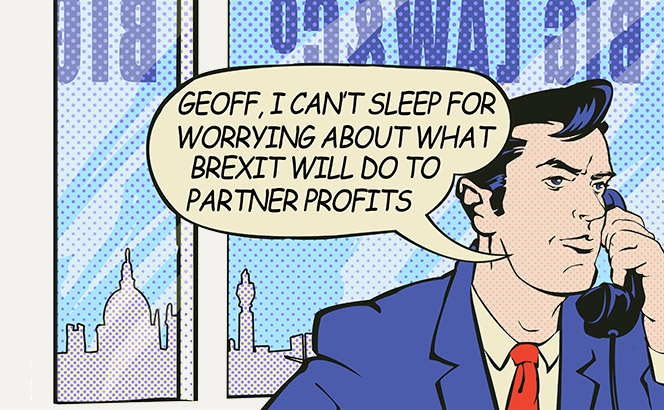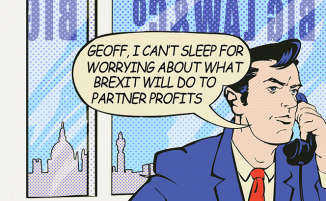On occasion, we are asked to give our house view at partner conferences and the like. Undertaking one such gig last month for a top-50 UK law firm while the government unhelpfully melted down in the background, I put down some notes on the outline questions the law firm asked me to address before the conference. Obviously, I was not reading my notes in front of the audience in a two-way Q&A and did not stick to the script, but with a little scrubbing up and the identifying information removed, the notes seemed a decent compilation on the kind of topics that Team LB is frequently asked to opine on.
***
The business section of the Evening Standard this year stated the UK’s legal services industry is worth some £30bn a year, but ‘it’s also a fragmented and archaic beast ripe for consolidation and disruption’. Do you agree?
Legal Business: How would the Standard know? Complex supply chains, globalisation and modern technology mean many industries are hard to understand these days without a lot of attention, and law is no different. That is why it attracts a lot of one-dimensional commentary of little value.
Some of the supposed ‘fragmentation’ is the result of conflict rules and the reality that law firms have until recently only had moderate needs for capital (that is arguably changing). Most commentary doesn’t consider the basic buy/sell dynamic between law firms and in-house legal departments. It doesn’t even grasp the underlying incentives of both sides, certainly in what are called ‘clients’, though they mean the in-house legal teams that are more accurately the agents of the client. That’s the industry’s agency problem.
There is some truth to the above claim – though I’d argue that the worship of margin, full-distribution partnerships and overly restrictive business models are bigger issues in making conventional law firms open to disruption – but it’s more complex than that.
To be clear, I do believe that structural pressures are building in the legal industry and these pressures threaten violent change, but I wouldn’t put low levels of consolidation particularly high up the list of reasons.
What do you see as the critical success factors for high-performing mid-tier firms? How must they differentiate to achieve success?
LB: Our cover feature at the end of 2017, ‘Reversal of fortunes’, was the most in-depth look we’ve ever taken at that topic. We chose three firms – Fieldfisher, Osborne Clarke and Watson Farley – there were several other contenders. The idea was to work out if there were any common themes or traits.
As much as we could find common ground – and I wouldn’t overstate that ability – the positive unifying trends included realistic strategies, competent leadership and governance, and simplified businesses. If I had to pick the most important of those, it would be the latter: law firms appear to do badly with complex practice and organisational structures. Harder to galvanise. Simplification also leads to clearer external differentiation. That said, differentiation is nice, not essential. I’ve seen plenty of very successful businesses that you’d struggle to give high marks to on that point. It’s not an end in itself.
A related observation is that law firms should pursue sustainable organic growth, which sounds ridiculously obvious, but law firms are prone to worshipping short-term margin above all else. There is a demonstrable statistical link between law firms that sustain growth and firms that improve profitability and retain partners. And successful law firms need good partner morale – law firms should monitor senior associate and partner retention more closely than they do as a canary in the cultural coal mine.
That said, many successful law firms don’t have a clue why they’re successful. They tell themselves stories, but they don’t really know. Success is inherently hard to pin down and business media in general has a poor record in identifying it.
What have you seen firms doing to address the traditional approach to legal practice and how have they managed to transform themselves significantly?
LB: They haven’t. The models kicked around now are just variations on themes being deployed 25 years ago, albeit with tech that has inevitably moved on. Tech-assisted volume arms are more than 20 years’ old. Commoditisation is much older than that. The post-banking crisis pivot led to more attempts to build LPO-like structures within law firms and that’s picked up some pace. That is a dilemma for law firms because they have to decide if that’s a game they play or not. For some the answer should be no. For some it may be the path leading to a substantial shift from conventional law firm to legally-driven professional services group.
What do you think were the key drivers behind the CMS Nabarro Olswang and the BCLP mergers, and do you think they have achieved their objectives? Do you see more on the horizon beyond the Ince tie-up with Gordon Dadds?
LB: I’m not the biggest fan of the CMS deal or BCLP union. CMS has to prove that it can organically grow rather than just use the CMS structure as a means to mask indifferent performance. That said, for where its legacy firms had gotten to, there was a hard logic to the union. And given its market positioning, it makes some sense. The doubts are about ability to galvanise a sprawling firm with a partnership culture you wouldn’t call driven. BCLP, hmmm… it’s odd. BLP did amazingly well during the 2000s and then suddenly loses its footing and nerve. Again, you can give them credit for choosing a path rather than wallowing in inertia, but there are questions hanging over both legacy firms. They have a lot to prove. Ince/Gordon Dadds – I’m torn between being confused and unimpressed, but I put in the caveat that it’s such a new kind of deal that I’ll reserve judgement.
How seriously do you take the rise of New Law providers in attacking the market share of mid-tier law firms?
LB: They’re a force. Luckily, they are largely built on being slightly less expensive than very expensive law firms and law firms are picking up their kit as fast as they can steal law firms’ lunch. That said, they’re having an impact on the market and a positive one at that. I suspect a handful will become big brands within ten years and then have the potential to rapidly scale up globally. At that point, they would rapidly move from manageable competitive threat to very dangerous for many law firms.
How closely are clients looking to law firms to adapt to their changing needs?
LB: You don’t see huge changes. In-house teams are usually too poor at process to re-engineer buying legal services. They have too many incentives to maintain the status quo.
Are you expecting to see further innovation and greater use of AI in the delivery of legal services?
LB: Yes. It’s inevitable. It won’t be that pretty either in the medium to long term. I hold to neither the Panglossian view of tech or the Terminator vision. It will be something in the middle with winners, losers and some wrenching change alongside the opportunity. And law firms haven’t even begun to address what this means for training lawyers.
In what ways do you think the GC role has evolved and will evolve? How do you see the changes in in-house teams impacting on the work and role of law firms?
LB: The calibre has improved, and the size of the talent pool and number of quality people that aspire to work in-house has surged to a level that is not always understood. Some law firms are haemorrhaging mid-level associates to in-house teams. The fundamental change is that law firms have become competitors to their own clients and the wheel keeps turning. That’s unleashing some unusual market dynamics.
More and more, clients are asking their panel firms to collaborate. In a competitive environment, where and how have you seen it work well?
LB: We’re pretty cynical about the collaboration bandwagon. Sometimes, it is right for the client and the job at hand, but it’s also frequently become a vacuous platitude in corporate circles.
How successfully are firms addressing different generational attitudes to work? What does best practice look like?
LB: Not great. They are still largely in thrall to older partners, many of whom are not driving the business. Ironically, neither do they productively use people past their mid-50s on the whole. US firms do better on this point. I’m not sure that the holding back of partnership is sustainable at many firms. Kirkland has come up with the most compelling answer to this with the dual tournament structure to engage the talent younger.
Where have you seen law firms using social media effectively, for example on recruitment, new business or influencing?
LB: Can’t say I’ve noticed it. Large law firms are not naturals at social media, not that it much matters in institutional services.
What firms are making strides on the D&I [diversity and inclusion] and CSR agendas, and why have they been successful?
LB: Major law firms don’t have much to boast about on diversity and inclusion. Perhaps it would be better if they just kept quiet about it. Even as a hard-nosed capitalist you get to a point where you think: this is just ridiculous! Let’s be honest, they just don’t care. I’ve heard that honesty is ‘authentic’.
What do you think (given the above issues to address) should be the top three priorities for today’s quality mid-tier firm to address?
LB: Simplicity is good. Can you narrow down what you do, your business model and structure so you focus on what you do well. Do you have a clear structure with clear accountability? Very obvious but still rarely done because it involves hard choices and a lot of office politics.
The second point is sustainable growth. Do you have it benchmarked against peers? If not, you should at least start asking why and get the debate going about how to rectify that.
Honestly, I’m not sure I can think of a third one beyond saying try thinking about what you want to be as an outfit. Independent thought is underrated; maybe try that. Or build a sales team. Not marketing. Sales. With commission. That would be original.













